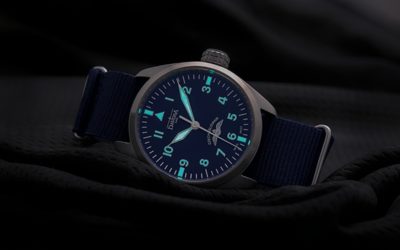A watch is not just a utilitarian object, but also a piece of jewellery and an investment opportunity. Mario Gašpar came to give a lecture about all this on Tuesday 4 February. This great watchmaker, contributor to the largest watch forum in the world Watchuseek and representative of well-known Swiss and German luxury watch manufacturers took us through the history and present of watchmaking. Do you know what we learned about investing?
From sundials to 1.5 billion units sold
It all began 3,500 years BC in Egypt. That’s when the first documented time measurements were made. But back then, it was just a sundial. The first mechanical pocket watches didn’t come along until 5,000 years later. It was designed in 1511 by Peter Henlein, a German locksmith living in Nuremberg. It was called the Nuremberg Egg after the place of its creation and its shape. The beginning of watchmaking as an industry can be traced back to 1601 and the Swiss city of Geneva. At that time, the production of a single piece could take several years. Back then, it was still unthinkable that watches would become a huge business and 1.5 billion pieces were sold annually. What has changed?
Two reasons to buy a watch
Making a classic watch with a mechanical movement is still relatively difficult, yet it hasn’t been the only option since 1969. That’s when the Japanese company Seiko came up with the quartz watch movement. This was lighter to manufacture and much cheaper. However, it fell short of the quality of a classic mechanical movement. But it was a fundamental change. Watches ceased to be just a luxury that is literally handed down from generation to generation, but also became a consumer product. Thus, there were at least two reasons for buying a watch, the first, emotional, was that the customer did not look at the price, but invested in quality, the brand and his image. They preferred a classic mechanical movement to a quartz movement. He preferred durability even a few generations before a few years of use.
Mechanical watches are gold with ratchets
Another essential aspect of buying a watch is shown in one of the most famous watch stories. Its protagonist is a watch with a mechanical movement, the Omega Speedmaster Professional. This mass-produced model won NASA’s rigorous tests and was the first watch to be in space in the Gemini 4 project in 1965. The same watch won tests in the following years and, along with the Apollo 11 project, made it to the surface of the moon in 1969 on the hands of Buzz Aldrin. Then a year later, on Apollo 13, it allowed the crew to time the rocket’s ignition and set a course for home. So their quality hasn’t aged over the years, and their price has corresponded, rising rather than falling over the years. In that way, they can be similar to gold. For example, the price of an Omega Speedmaster Professional “Moonwatch” rose by around £628 between 2014 and 2020. Its current price is £3,238. Inflation? No! The average price increase over 10 years was 6.1% per year, whereas the average inflation rate was only 1.3%.
Independent watchmaking
That the price of a watch can exceed its practical value by many times is also shown by the so-called independent watchmaking industry. An example of such handmade watches is ArtyA, whose watches are worth several million crowns. These watches are often one-of-a-kind, so the wearer receives a unique masterpiece. In addition to the usual precious metals and gemstones, the production material of such models is also stainless steel treated with lightning, tropical butterfly wings or real, fired bullets. In previous projects, Mr. Yvan Arpa (ArtyA) has also used parts of the rusted-out Titanic structure, part of the Apollo space shuttle or even moon dust.
Watches as an investment option
Watches can therefore go beyond being a purpose-built commodity and become a collector’s item whose value grows over the years. The same applies to certain limited edition models. Mario Gašpar, in cooperation with the traditional watch company DAVOSA (headquarters in Germany, production in Switzerland), produced one of these watches to commemorate the 75th anniversary of the Battle of Britain in a total of 54 pieces (54 Spitfires with Czech and Slovak pilots returned to the airport in Prague after the battle). Priced at CZK 17,500, the watches were already sold out a year before delivery and the price had risen by 20-30% by the day of delivery.
Current investment opportunity
This project by Mario Gaspar and DAVOSA is fortunately not unique. Another limited series of watches, this time dedicated to the conquest of the North Pole, is currently going into production. DAVOSA will produce 300 of them, which will make it possible to reduce the purchase price by 3 to 4 thousand, while keeping the quality the same. A guarantee card or other reminders of the unique adventure are a matter of course. The watches will only be sold through a special portal, but there is now the possibility to participate financially in their production with an interesting return.
Are you considering buying a watch or investing in its production and have additional questions? Feel free to contact us, we will explain everything you need.

